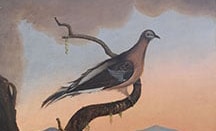Stay up to date with our newsletter
Passenger Pigeon
On September 1, 1914, the last remaining passenger pigeon, named “Martha” after Martha Washington, died in the Cincinnati Zoological Garden. Billions of passenger pigeons once darkened the skies in North America and possibly the world. So large were the flocks of pigeons that one farmer from 1825 complained of needing to guard his crops against the “feathered avalanche” as thousands of passenger pigeons descended on fields of corn, wheat, and barley, and after an hour, had devoured every kernel.

The extinction of the species is linked to habitat loss and the rising demand for food by the growth of eastern and midwestern cities. By 1855, 300,000 pigeons per year were hunted in the Midwest and sent to New York City as a source of cheap meat for the expanding human population. At the height of massive hunts to supply eastern markets in the 1870s, an army of 500-1,000 professional hunters, or “pigeoners” used telegraph and rail to track and pursue flocks to well-known roosting sites. The “great killing” in Michigan in 1878 yielded 300 tons of passenger pigeons, packed 55 dozen to a barrel, and shipped by rail to New York.
Mainers also hunted pigeons to sell locally and elsewhere for food, but on a smaller scale. As in other states at the time, sports hunters in Maine also frequently participated in passenger pigeon shooting tournaments, such as one in Lewiston in 1878, when 800 birds were shot over two days.
Commemorate the passenger pigeon’s extinction by creating your own flock of origami pigeons!
You can use regular office paper or origami paper. Check out the video to learn how!
